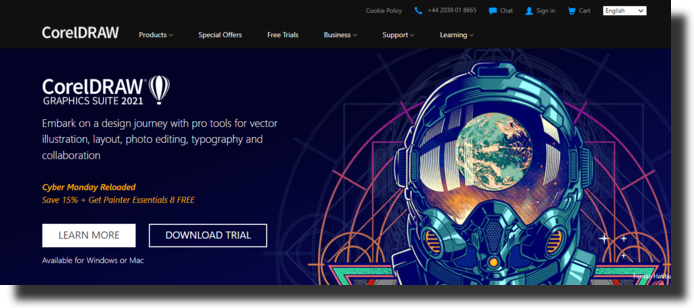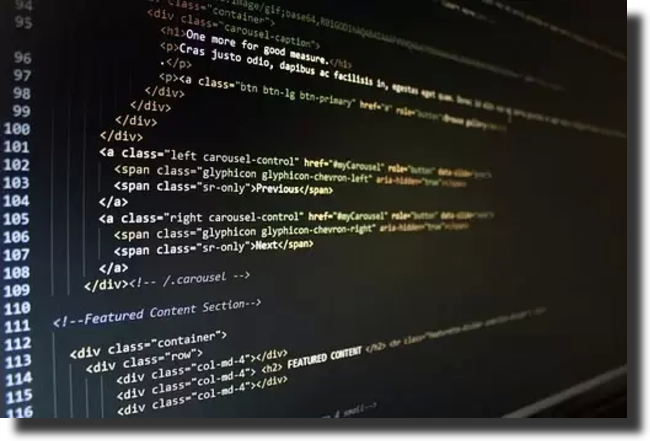When building your website from nothing, you’ll need a designer to make it feel and look like you and most importantly your users want. Also, you need a developer to create the foundation for your sire.
With everyone using the internet to find supplies and necessities, web development is even more important today to a business’ success.
That means web design and development are things you can’t ignore when starting your business.
The truth is, designers and web developers are responsible for different areas and have distinct roles when building a website.
We’ll later look at and explain the differences between web designer and web developer. This way you’ll have the necessary information to help you choose the right one for your website.
Here’s our guide on how you can tell the web designer vs web developer roles apart. That said, what is the difference between design and development?
What is Web Design?
Web design meaning encompasses the aspects of user experience in website development over software development.
Earlier web design focused more on designing sites for desktop browsers. But, from the mid-2010s, design for tablet and mobile browsers has increasingly become even more important.

Web design encompasses several fields including User Experience (UX), User Interface (UI), and SEO (Search Engine Optimization).
Overall, web design should acknowledge a website or app usability considering its structure (i.e layout), visual aesthetics such as fonts and colors), and even the content.
Who’s A Web Designer?
A web designer makes a website look good. That means a web designer works on the layout, appearance, and, sometimes, on the website’s content.
The appearance of a website relates to the images, fonts, and colors used. As such a good website design should be aesthetically pleasing, easy to use, and suitable for the brand and user group of the website.
So, what does a web designer do? The primary responsibility of a Web Designer is focused on the overall feel and style of the website. They use different software like Corel Draw, Photoshop, etc to make your website more attractive.

Typically web designers have a specialism meaning there are different kinds of web designers depending on their role. Some of these roles include:
User Interface (UI) Web Designer
UI web designers help improve how users interact with an interface or elements on your website.
That’s done by when the web designers translate brand values and complex ideas into a website that’s easy and enjoyable to navigate.
User Experience (UX) Designer
The responsibilities of UX web designers involve keeping your visitors hooked. They know how to build a website that’s enjoyable to your specific audience.
What’s more, they’ve done extensive research on website needs and users’ demographics along with tons of site restructuring and prototype testing.
The thing is if people enjoy visiting your website, they’re likely to recommend and even revisit. This way it’ll help you grow your online following.
How does UX differ from UI? UX focuses on research to help build a solid foundation to guarantee an amazing user experience. On the other hand, UI involves the look and feel of your website.
Visual Designer
Visual designers are a mix of both UI and UX. They not only help improve a user’s journey using their coding and creative skills, but they also solve design issues.
Visual designers also help bring to life a brand’s unique tone of voice and style. Inherently, they’re masters of all aspects of web design and their unique roles will vary greatly based on your wants.
What Web Designer Skills To Look Out For
So, what does a web designer do? And what web designer skills should you look for when hiring a web designer? Web designers must be creative to help make your website visually appealing.
Additionally, they should have in-depth knowledge of graphic design.
Some web designers even have a preferred platform. That means a web designer, for instance, specializes in the customization of Shopify templates.
Also, others have amassed lots of knowledge of most of the major platforms ensuring they can work with more clients.
Web designer skills that are a must-have are great communication skills. This allows them to easily work with developers, clients, and other parties involved in a project.
Additionally, web designers should know how to interpret a client’s needs and execute them into a website design.
What’s Web Development?
Web Development meaning – this is a process of developing applications and websites for intranets (private networks) and the internet.
The process of web development can include different specializations. This entails working on a web server, network security configurations, web engineering, and to some extent web design.
Still, the everyday usage of “web development meaning” typically implies writing mark-ups, coding, therefore, it does not take account of design aspects.

In such an instance web development meaning does not include web design since it’s used to express writing code, markups, and in general other back-end development-related responsibilities.
Therefore, when looking at web designer vs web developer, both can sometimes seem like separate subjects; however, it’s not that apparent.
Who’s a Web Developer
Web content developers are commonly called programmers. Developers take design concepts created by web designers and translate them into a fully functional website.
Usually, when looking at web designer vs web developer; developers specialize in designing apps while web designers focus on what users will enjoy doing.
Web content developers often use various software and tools such as ASP.NET, Python, JavaScript, Node.js, jQuery, PHP, among others.

The primary aim is to build you a smooth-running and well-functioning website. Also, web developers collaborate with visual designers, UI designers, and UX designers to build web pages depending on the designs the designer provides.
Like web designers, web developers have specific roles which we’ll look at below.
Front-End Developer
Front-end developers are also called client-side development. They’re more linked to web design over back-end development since this process involves the use of JavaScript, HTML, and CSS to create features that users can see, for instance, client lead forms.
Also, front-end developers have coding skills. However, they build frameworks that users can interact with.
Back-End Developer
Your website’s core structure is designed in the back-end. Back-end developers are skilled in programming and they use complex software languages such as SQL, Java, and C#.
These developers do jobs that aren’t seen by users. That’s because this involves coding on databases and web servers, but not on browsers (unlike front-end developers).
That means back-end developers’ job involves creating logical and functional websites using different programmes. Additionally, they take time to test and fix bugs.
Full-Stack Developer
Full-stack developers work on different stacks – or layers – and this includes the front along with the back end. When it comes to web development you’ll get the full package, because they’re experts in all areas.
What Skills Do Web Developers Possess?
Web developers need to learn several programming languages. Front-end developers need to learn JavaScript, CSS, and HTML.
As for backend developers, they need to learn Java, Python, Ruby, and PHP. In addition, web developers use database systems like Oracle and SQL.
Ultimately, web developers should have great communication skills so they can easily work with clients, web designers, and other people involved in a project.
Web developers’ skills should allow them to work with clients. This way they’ll interpret client needs, and in turn, deliver them high-speed functionality for their website functionality.
How Google Measures User Experience
In general, Google wishes to give the best possible user experience to anyone who uses their search engine.
That means Google expects websites that appear on the first SERPs page – and in particular mobile SERPs – to keep their visitors engaged while providing an amazing user experience.
If your visitors experience slow website loading times or when they don’t find what they’re searching for, they’ll immediately leave your website. This is recorded in Google Analytics as part of your site’s bounce rate.

What would happen if you and your competitor both are ranked highly for the same search words, however, your website records a higher bounce rate over theirs?
In such an instance, Google will probably move your competitor higher than you. That’s based on the assumption that your competitors’ site can deliver more of what Google search users are searching from that query.
This means if your site experiences high bounce rates, then you’ll need the services of a team of experienced web developers, web designers, user experience specialists, as well as search engine marketers.
Such a team will help you determine why web visitors are clicking away from your website. After they’ve figured out the issues, they’ll assign the right person to handle each issue.
When Do You Need A Web Designer vs Web Developer?
The table below includes descriptions of different projects and whom you should choose for each one. We aim to help you understand when to hire services of web designer vs web developer.
| Project | Who You Need |
| Building new contact forms | Web Developer |
| Edit videos and photos | Web Designer |
| Design a layout for a new homepage | Web Designer |
| Fix hosting or server issues | Web Developer |
| Creating mobile apps | Web Developer |
| Conceptualizing new website branding | Web Designer |
Websites Designed with SEO in Mind
For your business to succeed in 2022, you need a business website that appears higher on search results. The top source of traffic for most businesses is organic SEO.
Fortunately, once your site starts ranking higher for your top keywords, you’ll start seeing improved traffic to your site.
What’s more, you won’t have to pay for ads through Bing Ads, Google Ads, and similar services. There’s a good reason why you want to outrank your competition in search.
Ranking on the first page of search results means you’ll have an increase in the number of clicks to your website. Ultimately there are three components to SEO – off-page SEO, technical SEO, and on-page SEO.
Technical SEO and On-Page SEO
On-page SEO involves optimizations that ensure that search crawlers can understand your content easily. This ensures your website is indexed correctly for people searching online for it.
On the other hand, technical SEO is optimizations that you can make to your website functionality, code, or server thus search crawlers can easily find your content.
For a solid on-page SEO and technical SEO, your web designers and web developers can deliver this from the moment you launch the newly redesigned or new website. They can do this by:
- Configuring your hosting server settings to give you the best performance possible
- Optimizing images and content within the design without compromising its quality
- Writing clean, yet error-free code for your site
- Creating URLs with keywords in mind and using filenames
- Including specific business details (such as phone number, name, and address) in the text rather than in the footer or header image only
- Testing and debugging web applications before launching to guarantee that there’s no loss of conversions resulting from missing pages, slow loading, or other hard-to-use features.
For this reason, you need to work with web designers and web developers who factor in search engine ranking. This ensures you get a website that functions smoothly, looks amazing, and loads at fast speeds.
The emphasis on speed here is because Google has upgraded its algorithm. And it allows them to rank websites with faster load time.
With faster performance, a website offers an enhanced user experience on all devices with a higher ranking for mobile-first search results.
To ensure your website earns higher mobile traffic from various search engines, you should ensure it runs without issues and fast.
Maintaining Your Website
Realize that redesigning an old website or launching a new one is the start of your website marketing.
By choosing the right company for your web design, you’ll also have access to services to boost your website’s visibility and maintenance.
Once your site is ready, the website marketing team will start promoting it using off-site SEO strategies. Your marketing teams will also share high-quality content, reach out and get links from relevant partners.
Thereafter, you’ll soon see increased leads and social following, improved website traffic, and sales. These ongoing actions are a necessity for businesses that are looking to stay ahead of their competition.
As such, when your business stops marketing your site and your competitors keep on promoting their site, they’ll soon be the ones attracting customers and traffic online.
Difference between Web Designer vs Web Developer
Now that you know who a web designer and web developer is. It’s also important to know this stuff about the differences of both as it’ll simplify your website-related life.
So, what is the difference between design and development? Our table below takes a quick look at the differences between web designer vs web developer.
| Web Designer | Web Developer |
| They are by nature very creative. | Web Developers tend to be more technical. |
| Web designs focus on how websites look and feel on the outside. | Web development meaning is all about the functionality of how a website works. |
| Web designers transform clients’ ideas into designs that are visually appealing. | Web developers transform web designs into fully operational websites. |
| Often web designers offer the aesthetic aspect. | Web development involves creating user-friendly websites depending on a client’s specifications |
| Web designing tools used include Sketch, Adobe Photoshop, Figma, Illustrator, etc. | Languages used in web development are CSS, HTML, Ruby, PHP, JavaScript, Python, jQuery, etc |
Should You Hire a Web Developer or Web Designer?
This guide has explored the key differences between a web designer and a web developer. Even then, many businesses prefer working with a company like UPQODE that offers web development, design, and marketing services.
Such an approach lets you work with a team of web developers and web designers who join forces to build your perfect website and web applications.
For best results, you should have your business website designed and developed by a company that delivers you a website that people enjoy using and that can be found by search engines.
Search optimization also ensures that visitors can easily find your website. As such, user experience optimization increases the chances of visitors finding your site, using it, and even converting.



